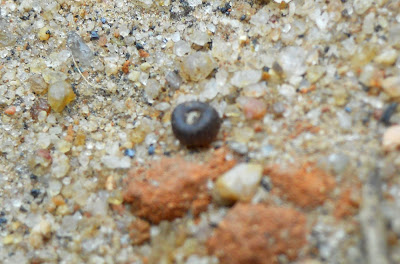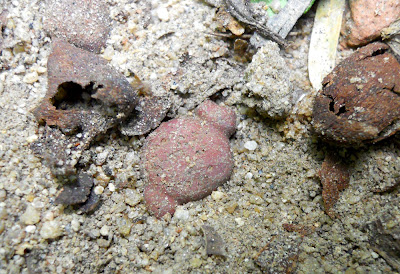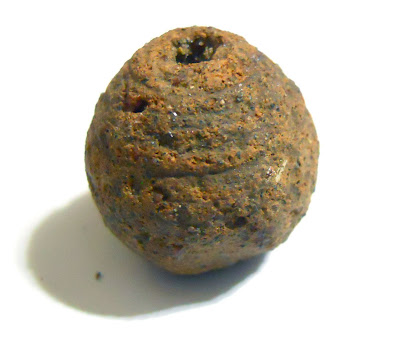Beads of India
The aim of this blog is to catalog and study as many ancient beads found in India as possible. The blog will feature high quality images of beads and other related items. Latest discoveries and theories on the bead trade from India will be discussed in length.
Sunday, January 23, 2011
Saturday, January 22, 2011
Arikamedu: Quartz Bead
On a recent visit to Arikamedu I was fortunate to meet a local man from the village of Ariyankuppam. He informed me that he has been collecting beads from this area for the last 15 years as they turn up all over the place during the rains and when he goes for a walk through the area. He showed me a bead he had with him which I immediately photographed. It was a roundish piece of clear Quartz with pecking marks all around. This bead was a good find as this is an example of the early stage of the bead making process.

The bead making process is an interesting one and even today most beads are made in a similar fashion to the techniques that were used in Arikamedu 2000 years ago.
Rough stones would be brought to Arikamedu by land and sea from places like Gujarat, Erode and probably Sri Lanka. These roughs would then be chosen by the bead workers to make into beads. From various finds at the excavation site as well as objects in private collections, the entire process can be seen. First the stones would be chipped or "pecked" to form a rough shape as required. Usually beads were round, rectangular or cylindrical. The tools used for this process would have been harder stones like flint and iron pieces as they would chip stone when struck with force. A process similar to making stone age tools.
After the rough has been formed, it would then go to the drilling stage and from there for polishing. Beads in various stages of finishing have been found at arikamedu.

The bead making process is an interesting one and even today most beads are made in a similar fashion to the techniques that were used in Arikamedu 2000 years ago.
Rough stones would be brought to Arikamedu by land and sea from places like Gujarat, Erode and probably Sri Lanka. These roughs would then be chosen by the bead workers to make into beads. From various finds at the excavation site as well as objects in private collections, the entire process can be seen. First the stones would be chipped or "pecked" to form a rough shape as required. Usually beads were round, rectangular or cylindrical. The tools used for this process would have been harder stones like flint and iron pieces as they would chip stone when struck with force. A process similar to making stone age tools.
After the rough has been formed, it would then go to the drilling stage and from there for polishing. Beads in various stages of finishing have been found at arikamedu.
Friday, January 7, 2011
Tuesday, August 31, 2010
Arikamedu Beads
Chennai saw a few days of heavy rain in August 2010. When the rain stops, it is always a great time to visit archaeological sites! The entire area is washed clean, the dust settles and the hidden artifacts emerge on the surface making it easier for us to make new discoveries.
This time we chose to visit the ancient Indo-Roman site of Arikamedu. This site has always been of great interest to archaeologists. The earliest documented excavation was by Mortimer Wheeler in the 1940's. He was a well respected and heavily published archaeologist. He conducted an extensive excavation at Arikamedu. This excavation threw up so many artifacts that it brought to light a very important period of India's past; the Indo-Roman trade. However, at that time there was a lot of debate as to the origin of these artifacts. It was concluded at that time that most artifacts found there were of Roman origin and that a lot of pottery techniques found in India originated from Roman techniques. Of the objects found, the most numerous were glass beads and stone beads. This was followed by Roman pottery shards, Red & Black ware, Polished ware and some coarse indigenous terracotta.
 ABOVE: Image 2: Brick walls exposed along the river bank. Wheeler.
ABOVE: Image 2: Brick walls exposed along the river bank. Wheeler.
BELOW: Image 3: View of river bank covered with bushes and litter. August 2010

Over the years there have been many other excavations. In the 1980's, Vimala Begley conducted vast excavations at the site. She helped to establish a longer continuity of the region. Her findings allowed us to understand that Arikamedu existed before the arrival of the Romans. There is extensive evidence of Red Ware, Red & Black Ware and Black Ware that are found in habitation mounds all over the area. As recent as January 2010, a sarcophagus and pottery were found a couple of kilometers away from the Arikamedu site. [Link to Article]
Peter Francis Jr. has also greatly contributed the the better understanding of this site. More of his fascinating work can be seen here: Google Books
Today, there is a much larger understanding of Arikamedu, its strategic location, its people and its association with the Indo-Roman trade. Over the years, layer upon layer has been added to the story of Arikamedu by its various researchers. To get a better understanding, one has to see the larger picture.
Arikamedu Timeline:
Arikamedu has been occupied of rover 2700 years. There is evidence that Pandukal people (commonly known as the "megalithic" people) settled in this area in the late Iron age around 500 BCE. There is extensive evidence of large stone circles and dolmens all over the area. There is evidence that this population traded Iron and beads with other regions in India as far away as Gujarat.
The Romans arrived in India through the sea route somewhere around 50BCE in the West coast of India during the rule of Agustus. After initial survey and trade inquiry, it is possible that they figured out a trade route through the Gulf of Mannar, made contact with Ceylone and up the East coast of India and finally reaching China.
There is some evidence that the Bead Trade in Arikamedu flurished till about 300 AD and later moved to an entirely new location at Papanaidupet.
Beads of Arikamedu:
Irrespective of the many types of artifacts found at Arikamedu, beads stand out the most. They are tiny however, found in the millions. This is not an arbitrary figure. Beads were the single larges quantity of products exported from India at that time. Even today, after numerous excavations, one can find thousands of beads scattered on the ground all over the site.
 Discarded end of glass tube. At the bottom of the above image, a 2mm diameter Black Glass Bead can be seen
Discarded end of glass tube. At the bottom of the above image, a 2mm diameter Black Glass Bead can be seen
This time we chose to visit the ancient Indo-Roman site of Arikamedu. This site has always been of great interest to archaeologists. The earliest documented excavation was by Mortimer Wheeler in the 1940's. He was a well respected and heavily published archaeologist. He conducted an extensive excavation at Arikamedu. This excavation threw up so many artifacts that it brought to light a very important period of India's past; the Indo-Roman trade. However, at that time there was a lot of debate as to the origin of these artifacts. It was concluded at that time that most artifacts found there were of Roman origin and that a lot of pottery techniques found in India originated from Roman techniques. Of the objects found, the most numerous were glass beads and stone beads. This was followed by Roman pottery shards, Red & Black ware, Polished ware and some coarse indigenous terracotta.
 ABOVE: Image 2: Brick walls exposed along the river bank. Wheeler.
ABOVE: Image 2: Brick walls exposed along the river bank. Wheeler.BELOW: Image 3: View of river bank covered with bushes and litter. August 2010

Over the years there have been many other excavations. In the 1980's, Vimala Begley conducted vast excavations at the site. She helped to establish a longer continuity of the region. Her findings allowed us to understand that Arikamedu existed before the arrival of the Romans. There is extensive evidence of Red Ware, Red & Black Ware and Black Ware that are found in habitation mounds all over the area. As recent as January 2010, a sarcophagus and pottery were found a couple of kilometers away from the Arikamedu site. [Link to Article]
Peter Francis Jr. has also greatly contributed the the better understanding of this site. More of his fascinating work can be seen here: Google Books
Today, there is a much larger understanding of Arikamedu, its strategic location, its people and its association with the Indo-Roman trade. Over the years, layer upon layer has been added to the story of Arikamedu by its various researchers. To get a better understanding, one has to see the larger picture.
Arikamedu Timeline:
Arikamedu has been occupied of rover 2700 years. There is evidence that Pandukal people (commonly known as the "megalithic" people) settled in this area in the late Iron age around 500 BCE. There is extensive evidence of large stone circles and dolmens all over the area. There is evidence that this population traded Iron and beads with other regions in India as far away as Gujarat.
The Romans arrived in India through the sea route somewhere around 50BCE in the West coast of India during the rule of Agustus. After initial survey and trade inquiry, it is possible that they figured out a trade route through the Gulf of Mannar, made contact with Ceylone and up the East coast of India and finally reaching China.
There is some evidence that the Bead Trade in Arikamedu flurished till about 300 AD and later moved to an entirely new location at Papanaidupet.
Beads of Arikamedu:
Irrespective of the many types of artifacts found at Arikamedu, beads stand out the most. They are tiny however, found in the millions. This is not an arbitrary figure. Beads were the single larges quantity of products exported from India at that time. Even today, after numerous excavations, one can find thousands of beads scattered on the ground all over the site.
 Discarded end of glass tube. At the bottom of the above image, a 2mm diameter Black Glass Bead can be seen
Discarded end of glass tube. At the bottom of the above image, a 2mm diameter Black Glass Bead can be seenSunday, August 22, 2010
A trip to the Madras Museum on Madras Day
This August 22nd a group of us visited the Madras Museum, Egmore to see a display of Urns from the Kilpauk excavations. This is a very important find as it creates a timeline of continuous habitation around Madras from around the Megalithic period (100BCE - 300 AD). Unfortunately only two Urns were on display. It was sad to see that the authorities had used upside down tables as stands for the Urns!



Please read the text in the image for more details.
After this we decided to visit the main gallery. Here we came across some beads that were on display from Mohenjo Daro. There was a set of three Carnelian Beads as well as Terracotta beads that were elongated with tapering ends.





Please read the text in the image for more details.
After this we decided to visit the main gallery. Here we came across some beads that were on display from Mohenjo Daro. There was a set of three Carnelian Beads as well as Terracotta beads that were elongated with tapering ends.


Monday, August 16, 2010
Grooved Terracotta Bead
Terracotta Bead



This is a terracotta bead found in Kumbakkonam. It was probably found in the Cauvery riverbed. This bead is 23mm in diameter and 14mm thick. It seems to have a tapered edge.
There are some references to terracotta beads from archaeological excavations. This bead, since it was found in the river, shows erosion damage. The bead has a rough surface.
The exact age of this kind of bead cannot be fixed but in association with the other objects it was found with, it can be dated to around the 10th - 12th century AD.
Subscribe to:
Comments (Atom)














